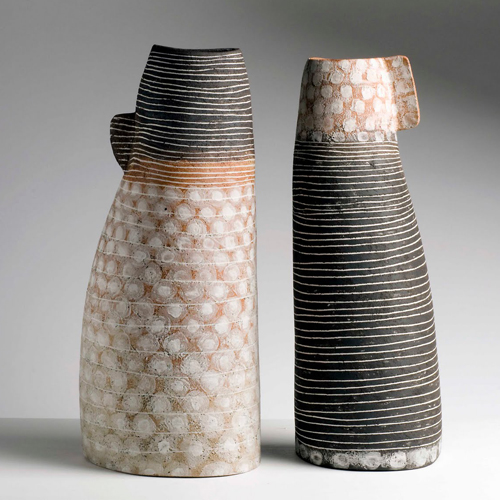Art of printing on ceramics
You can decorate ceramic objects with a pencil or trailer. Besides painting and drawing, however, you can also print the clay. There are numerous printing techniques for ceramics. The spectrum of graphic techniques on ceramics ranges from stamps, roll stamps, monotypes to screen prints.
The latest exhibition at Keramiekcentrum Tiendschuur Tegelen has invited an international selection of renowned artists. They are not afraid of working with the often complex or time-consuming techniques. They decorate their work via all sorts of roundabout ways and obstacles. Their impressive works of art prove that it is absolutely worth making a detour.
From cuneiform to stamp fever
One of the very oldest techniques is the printing technique on ceramics; here, objects are pressed into the wet clay. In this way, the Babylonians imprinted the oldest known alphabet, the cuneiform, into their wet clay tablets. Clay is soft, which is ideal if you want to make a relief imprint into it. The options are virtually unlimited. Throughout the centuries, many ceramicists have been infected with the stamp fever. Fingers, cogwheels, plants, leaves, tree bark, shells, rope, toys, antique metal objects and much more can be used to work the surface of the clay. In addition, it is very easy to make an object out of clay and, after it has been fired, use it as a stamp. This working method can be found with many ceramicists as a nice accent where the handles of a mug were put on. Or with the old Tegelen pot throwers as a relief decoration with a pudding or meat pasty mould.
Treasures of clay
Contemporary artist Kati Jünger (Munich, 1961) has embraced the stamp technique: it is characteristic of her work. She studied at the Gerrit Rietveld Academy in Amsterdam and at the University of applied arts in Vienna. Her work is studded with (inverted) stamps. The forms she applies to her work usually are positive forms that lie on top or, in other words, are high-relief. She applies small forms of clay to her objects which she has pressed into all sorts of moulds. She applies these small parts in a decorative way so that complex and fascinating structures in high-relief are created. They sometimes remind one also of treasure chests decorated with engraving, filigree and precious stones and jewels: not entirely coincidental… her father was a goldsmith.
Ceramic carbon paper
Another way of printing ceramics is to be found in the work of Elke Sada (Dettelbach, DE, 1965). She uses mono-prints. Here, the work is painted indirectly, as it were. First, a painting is made, on a sheet of paper or a gypsum board, with clay slips, oxides and/or colour pigments. Then, this painting or drawing, still wet, is pressed onto the clay and in this way the drawing is transferred on to the object. This is called monotype because the paining print can be pressed on to the clay only once, type stands for printing. It can also be done the other way around: a sheet of paper or plastic is rubbed with a ceramic colouring agent, then put on the object to be decorated with the coloured side. On the ‘clean’ back, a drawing is made with some more force and in this way the drawing is transferred on to the object. The same process as carbon paper, which has nearly disappeared today.
“Why take the difficult option if you can also take the easy one?”
The monotype technique raises the question: “Why take the difficult option, if you can also take the easy one”. In the case of ceramics, there are two reasons for this: first, it is often easier to make the drawing first on a flat surface than on a spatial object; gravity may also be a disturbing factor and the clay slip may start to drip too soon. Second: this working method offers the possibility to make the drawing more refined. Part of the drawing can be scraped away, so that during the transfer parts of the clay also remain uncovered. In addition, the lines are different from when they are drawn on to the object directly, sometimes slightly ‘woollier’, slightly softer.
Elke Sada and Martin Möhwald (DE) apply the monotypes to flat clay sheets and, after that, build their work with printed sheets. This is visible at the seams where the drawing stops abruptly. Möhwald even goes a step further, he tears up the prints into pieces and builds his forms with them. In this way, texts and pictures with tears across them are created. This has a special effect, the burst pictures remind one of wall paintings or vases from classical antiquity.
Two other exhibitors also working with monotypes are: Petra Bittl (DE) and Vicky Shaw (GB). Elke Sada’s work, expressive and exuberant, is the opposite of Vicky Shaw’s controlled, balanced and modest work.
The possibilities of screen prints are infinite
For Vicky Shaw are drawing, print-making and the connection between material and process all central to her practice as a maker. She draws inspiration from familiar objects subjectively chosen for their aesthetic qualities, they often have a reference to the domestic and the everyday. She works intuitively, enjoying the playfulness of composing with line, colour and pattern. Ceramic printing techniques offer Vick Shaw the opportunity to work in a precise way or if desired a less controlled way, allowing for the unexpected to arise..
Trough the screen, the prints are pressed on a thin flexible transfer layer with ceramic colours. Then these have to be cut out and arranged on the glazed works. During a third firing these prints are burned and sealed in the glazed surface of the works. The possibilities of these technique are limitless, photographic images can be used, they can be repeated, and the transfers can be used on curved surfaces and three dimensional objects.
Exhibitor Paul Scott (GB) is a master in the use of screen prints, he teaches about their use and has written books about them.
From cosy wallpaper to Avatar-like computer patterns
Ane-Katrine von Bülow (DK) uses the screen printing technique to make beautiful tight geometric patterns, which she puts as a net across her fragile porcelain bowls. Kris Campo (BE) plays with all sorts of decorative motifs, applying them as a small papier-maché to her usually tight geometric objects. Also with Kordula Kuppe (DE), the screen print can be found on her work in the form of a cosy wallpaper. Maria Geszler-Garzuly (HU), Manita Kieft (NL) and Nicole Thoss (DE) opt for photographic reproduction. In this way, Geszler-Garzuly provides her figures with faces, Thoss makes depictions that remind one of newspapers or old picture postcards , and Kieft creates a surrealistic atmosphere in which the photos don’t fit onto the forms they have been put on and walk off them. Steve Royston Brown (GB), finally, makes the designs for his prints on the computer. Once they have been screen printed, these multi-coloured folded-out construction sheets appear to fit exactly onto his tight services and spatial futuristic Avatar-like objects.
The exhibition opens at 16:00 on Friday 12 April and will be introduced, among others, by conservator Sacha Odenhoven.
The participating artists are:: Petra Bittl (DE); Kris Campo (BE); Maria Geszler-Garzuly (HU); Kati Jünger (DE); Manita Kieft (NL); Kordula Kuppe (DE); Martin Möhwald (DE); Steve Royston Brown (GB); Elke Sada (DE); Paul Scott (GB); Vicky Shaw (GB); Nicole Thoss (DE); Ane-Katrine von Bülow (DK).
Artists will be present in person on the dates below:
- 13 April 11:00: Vicky Shaw, demonstrates her techniques and tells about her work.
- 13 April 14:00: Maria Geszler- Garzuly, demonstrates her techniques and tells about her work.
- 10 and 11 April: workshop dealing with printing techniques on ceramics, organised on the occasion of this exhibition, is given by Maria Gezler-Garzuly.
- 25 May: workshop dealing with printing techniques on ceramics, organised on the occasion of this exhibition, is given by Netty Janssens.


